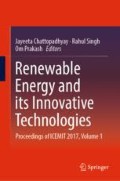Abstract
Sustainable use of natural resources is key principle in present environment. It requires maximum utilization with minimum environmental impact. Use of Freshwater algae is better option for this. Freshwater algae are photosynthetic lower plants having 50% of oil content in their weight. By simple reactions, algae produce carbohydrates, lipids, and proteins in heavy stock over shortest period of time. These products are further converted into bioethanol, biodiesel, and many more useful products. This study deals with biofuel production from the microalgae collected from River Baldi, Doon Valley, Uttarakhand. Some common species are Nitzschia sp., Chlorella sp., Cladophora sp., Zygnema sp., Spirogyra sp., Microcystis aeruginosa, Oscillatoria limnetica, Navicula sp. 19.5% of lipid was obtained from 0.758 g dry wt m−2 microalgal biomass harvested from River Baldi by using soxhlet extraction method by using chloroform:methanol (2:1) as solvent. Extracted algal biomass was hydrolyzed in the form offermentable sugar which was converted into 58% bioethanol. Algal biomass was utilized for biofuel production, in biotreatment to treat waste water and as biofertilizer to enhance crop production. Hence, Microalgae have 3B role (Biofuel; Biotreatment; Biofertilizer). The results shows that biofuel derived from freshwater microalgae act as better substitute to fossil fuels in future.
Access this chapter
Tax calculation will be finalised at checkout
Purchases are for personal use only
References
Kirtay E (2009) The role of renewable energy sources in meeting Turkey’s electrical energy demand. Energy Educ Sci Technol Part A 23:15–30
Briens C, Piskorz J, Berruti F (2008) Biomass valorization for fuel and chemicals production—a review. Int J Chem Reactor Eng 6:1–49
Mulbry W, Kondrad S, Pizarro C, Kebede-Westhead E (2008) Treatment of dairy manure effluent using freshwater algae: algal productivity and recovery of manure nutrients using pilot-scale algal turf scrubbers. Bioresour Technol 99:8137–8142
Olguın EJ (2003) Phycoremediation: key issues for cost-effective nutrient removal processes. Biotechnol Adv 22:81–91
Pizarro C, Mulbry W, Blersch D, Kangas P (2006) An economic assessment of algal turf scrubber technology for treatment of dairy manure effluent. Ecol Eng 26:321–327
Munoz R, Guieysse B (2008) Algal–bacterial processes for the treatment of hazardous contaminants: a review. Water Res 40:2799–2815
Amaro HM, Guedes AC, Malcata FX (2011) Advances and perspectives in using microalgae to produce biodiesel. Appl Energy 88(10):3402–3410
Schenk P (2008) Second generation biofuels: high efficiency microalgae for biodiesel production. Bioenergy Res 1:20–43
Arora N, Patel A, Pruthi PA, Pruthi V (2016) Synergistic dynamics of nitrogen and phosphorous influences lipid productivity in Chlorella minutissima for biodiesel production. Bioresour Technol 213:79–87
Ward JV (1974) A temperature stressed stream ecosystem below a Hypolimnial release Mountain Reservoir. Arch Hydrobiol 74:247–275
Wetzel RG, Likens GE (1991) Limnological analyses, 2nd edn. Springer, New York, pp 1–175
APHA (American Public Health Association) (2005) Standard methods for the examination of water and waste water. Washington, DC., pp 1–1368
Munshi JD, Roy SP, Munshi JS (2010) Manual of freshwater biota. Narendra Publishing House, Delhi, India, pp 1–435
Sharma RC, Singh N, Chauhan A (2016) The influence of physico-chemical parameters on phytoplankton distribution in a head water stream of Garhwal Himalayas: a case study. Egypt J Aquat Res 42(1):11–21
Bligh EG, Dyer WJ (1959) A rapid method of total lipid extraction and purification. Can J Biochem Physiol 37:913–917
Kumar V, Nanda M, Verma M (2017) Application of agar liquid-gel transition in cultivation and harvesting of microalgae for biodiesel production. Bioresour Technol 243:163–168
Crowell EA, Ough CS (1979) A modified procedure for alcohol determination by dichromate oxidation. Am J Enol Viticult 30:61–63
Hutchinson GE (1957) A treatise in limnology. Geography, Physics and Chemistry. John Wiley and Sons Inc., New York, USA 1957; I:1–1015
Ruttner F (1963) Fundamentals of limnology, 3rd edn. University Toronto Press, Toronto, pp 1–295
Sharma RK, Rathore V (2000) Pollution ecology with reference to commercially important fisheries prospects in rural-based water body: the Lake Sarsai Nawar, Etawah (Uttar Pradesh). Pollut Res 19:641–644
Chisti Y (2007) Biodiesel from microalgae. Biotechnol Adv 25:294–306
Abdo SM, Ahmed E, El-Enin SA, El Din RS et al (2014) Qualitative and quantitative determination of lipid content in microalgae for biofuel production. J Algal Biomass Utilization 5(3):23–28
Sawarkar LL, Nandkar PB (2013) Lipid content of some green algae for biodiesel. J Harmonized Res Appl Sci 1(3):77–79
Cheung PCK, Leung AYH, Ang PO (1998) Comparison of supercritical carbon dioxide and soxhlet extraction of lipids from a brown seaweed Sargassum hemiphyllum (Turn.), C Ag. J Agric Food Chem 46:4228–4232
Halim R, Gladman B, Danquah M, Webley P (2011) Oil extraction from microalgae for biodiesel production. Bioresour Technol 102:178–185
Sun Y, Cheng J (2002) Hydrolysis of lignocellulosic materials for ethanol production: a review. Bioresour Technol 83:1–11
Author information
Authors and Affiliations
Corresponding author
Editor information
Editors and Affiliations
Rights and permissions
Copyright information
© 2019 Springer Nature Singapore Pte Ltd.
About this paper
Cite this paper
Singh, N., Choudhary, B.K. (2019). Fresh Water Algae: A Best Option for Renewable Energy Generation. In: Chattopadhyay, J., Singh, R., Prakash, O. (eds) Renewable Energy and its Innovative Technologies. Springer, Singapore. https://doi.org/10.1007/978-981-13-2116-0_8
Download citation
DOI: https://doi.org/10.1007/978-981-13-2116-0_8
Published:
Publisher Name: Springer, Singapore
Print ISBN: 978-981-13-2115-3
Online ISBN: 978-981-13-2116-0
eBook Packages: EngineeringEngineering (R0)

